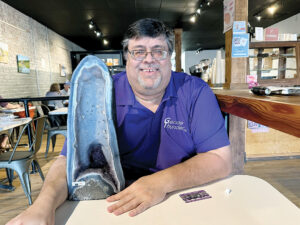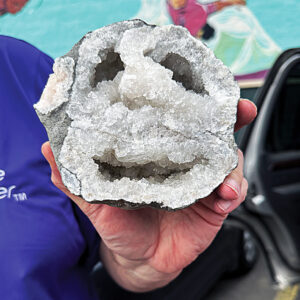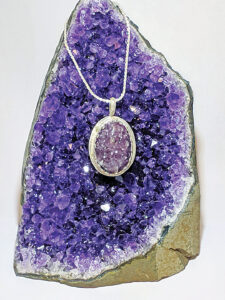Geodes reveal nature’s hidden beauty
4/3/2024
“They’re just Mother Nature’s gift to us,” said Ken Belzer about geodes.
People step on and over rocks most every single day without a second thought. They’re used in water features, gardens, concrete and more. Are most rocks just that, a rock? Not to Ken Belzer.
Belzer, born and raised in Des Moines, is a rock and geode enthusiast who began his hobby at 6 years old. He started picking up shiny pebbles on a trip to Mount Rushmore but didn’t get into rocks until he was in Boy Scouts.
“We went to a rock quarry, and I found a geode that I still have at home. I can remember climbing this pile of rocks and picking it up and throwing it at this big boulder trying to open it up. It just caught my attention, and I loved it,” Belzer said.
His collection of the crystal-filled stones began roughly 10 years ago. Belzer says he has thousands of geodes and similar items throughout his home.
“You take a rock like that (the gifted geode), and it’s ugly. But if you crack it open, it’s beautiful. You never know until you open them up,” Belzer said.

Mr. Geode will soon become the focus on Ken Belzer’s website.
Geodes are formed by pockets of air inside of rocks. Most often, when there are volcanic eruptions, after the lava cools from being shot out, it can leave air pockets within the hardened shell. Those pockets allow groundwater to seep in, which contains the minerals that form the geodes’ crystals. The different colors found inside the geodes come from whichever dominant mineral has seeped inside, with the most common mineral being quartz.
As for how to find them, the process is relatively simple.
“After you open a few of them, you get used to the weight. It’s just trial and error. Each one’s a little different. Some of them have big ‘snow balls’ in there, which make them heavy. It’s deceptive. Some of them are lopsided. Kind of toss them in your hand and determine it from there,” Belzer said.
As for where to find them?
“You can go down to Keokuk, and you can’t walk around without tripping over them. My first trip down there, I got several buckets and cracked them open,” Belzer said.
The large, purple-colored geode that Belzer brought to the interview is one he purchased, called a Brazilian Cathedral.
Belzer works with the Des Moines Lapidary Society, which puts on a show every October at the Iowa State Fairgrounds. The organization sets up booths for purchasing stones, geodes, jewelry and the like. Belzer gets great enjoyment from his role at the event.

Ken Belzer crafted this jewelry from one of his many geodes.
“I actually bring the fracking equipment with me. So I got it all set up there, and I bring buckets of unopened geodes. Kids will go through them and pick one. I’ll say, ‘Oh, I think this is the lucky one’ and they just get excited. And I get excited, too. I just tease and say, ‘Are you ready to see it? Are you really, really? Are you sure?’ And they’re just antsy to open it up. They’re the first person to see it (the inside of the rock) in millions of years,” Belzer said.
Belzer says there’s two types of geodes. There is volcanic, which are referred to as “thunder eggs.” These, for obvious reasons, would not be found here. In Iowa, geodes are sedimentary. Keokuk is located in the “Warsaw Formation,” a geologic formation that preserves fossils dating back to the Mississippian subperiod.
Belzer’s collection has been featured at the Urbandale library, where the Lapidary Society sets up an exhibit every year, and as part of demonstrations he has set up at schools for educational purposes.
While Belzer said it’s impossible for him to pick a favorite geode or a favorite memory showing them, he made sure to mention one.
“It was in a reject pile down in Keokuk. At this shop, they were just going to throw it out in the garden or something. But it looks like two eyes and a mouth, and I nicknamed it Mr. Geode, Sr. because people will call me Mr. Geode,” Belzer said. ♦





















